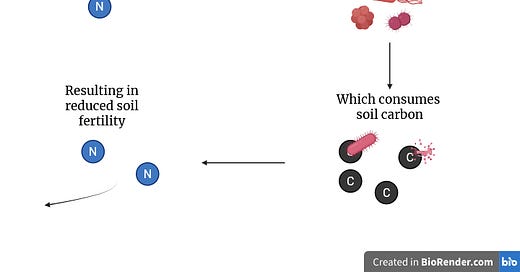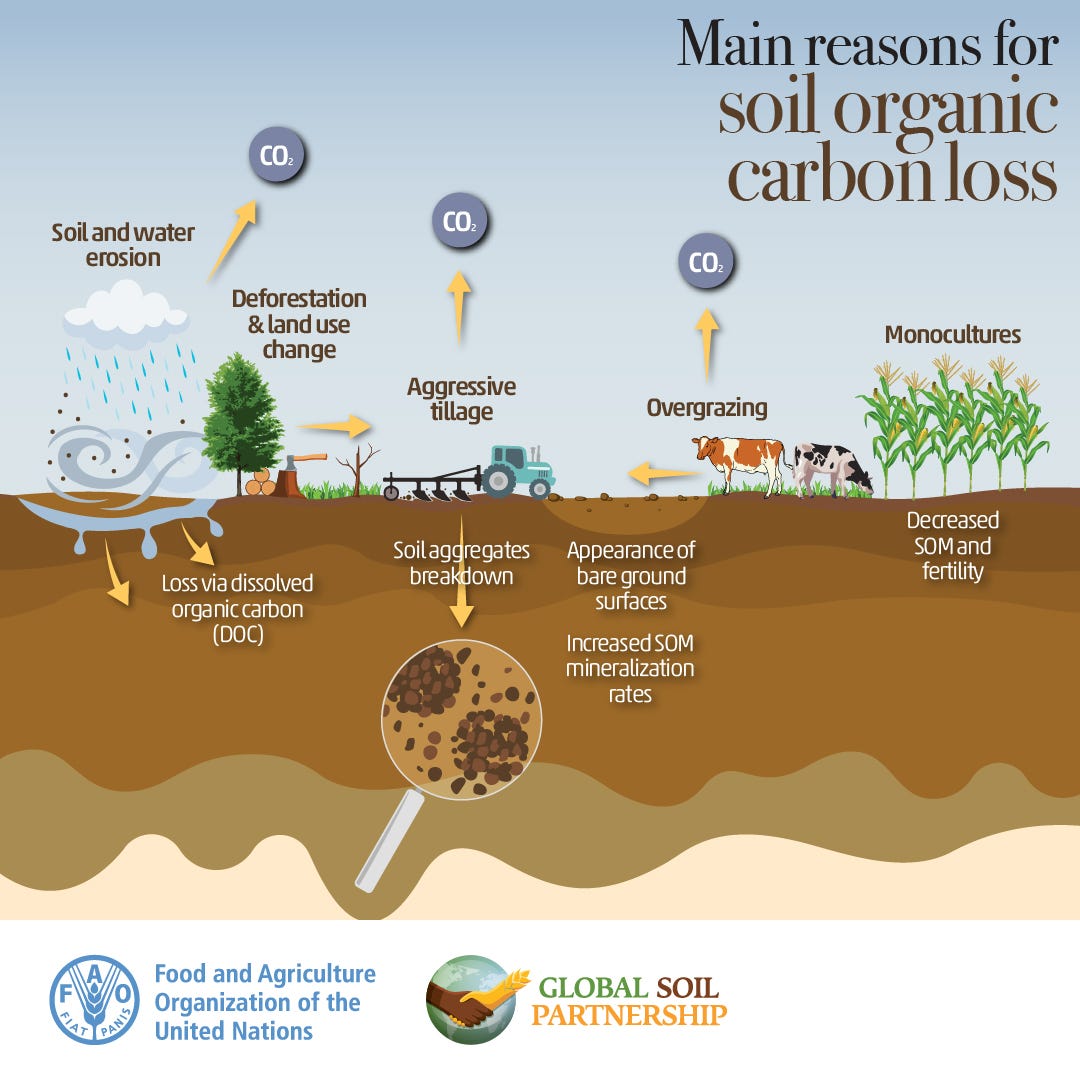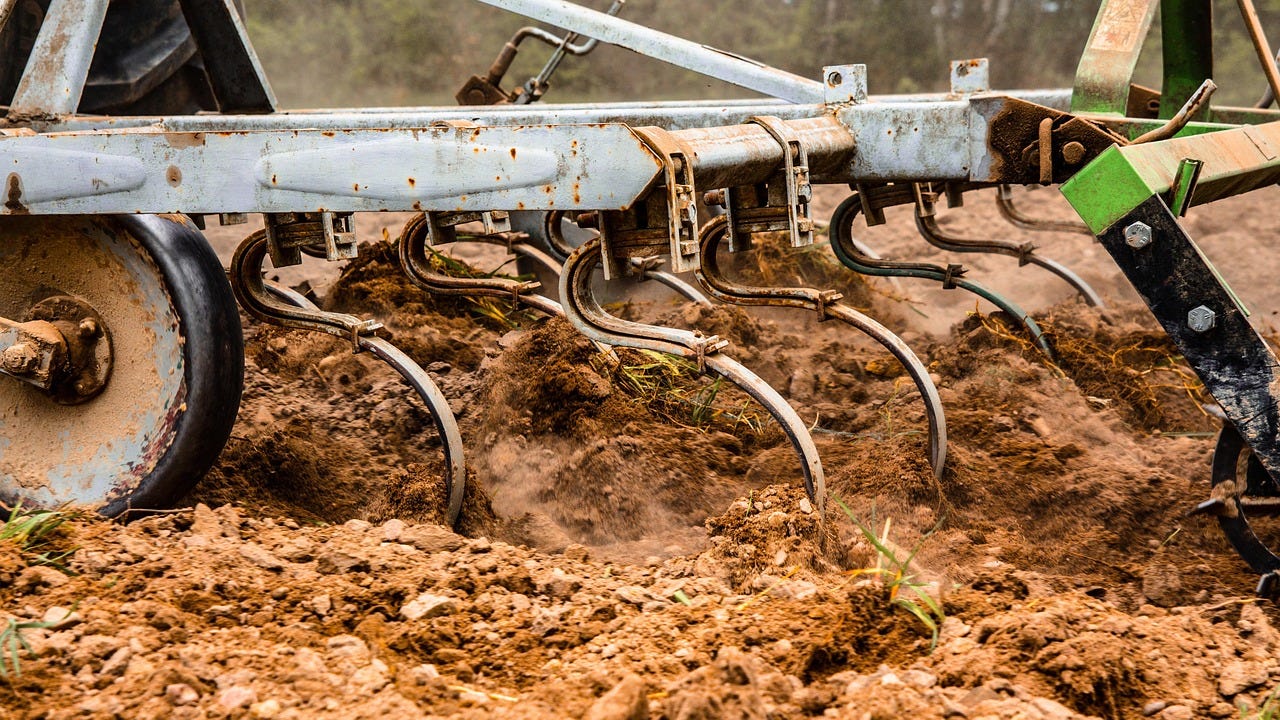Since the First World War synthetic fertilizers have revolutionized food production. Driven by the Haber-Bosche process, which converts atmospheric nitrogen into a form that can be taken up by plants, this innovation in chemistry is directly responsible for up to half of our food supply (Smil, 2004). These advancements, however, are not without their issues. From greenhouse gas emissions to water pollution, contemporary fertilizer practices carry a heavy environmental toll. In addition to these material issues, organic farmers and consumers maintain philosophical opposition to synthetic fertilizers, viewing them as unnatural and antithetical to natural food production. Since the mid-2000s, however, a new concern has emerged at the forefront of agroecological discourse: the idea that synthetic fertilizers are directly destroying the health of our soils.
Two papers, published by the lab group of Richard Mulvaney from the University of Illinois, are what sparked this dispute. The overarching message of their research is that fertilizers, over time, drive the degradation of soil health and fertility. The mechanism they propose is that microbial populations, constrained by a lack of nitrogen, experience a massive population boom from the addition of ammonia or urea. These microbes then, the theory goes, launch a buffet of available organic matter, which is mostly decomposing plant and fungal tissue, burning through this critical component of the soil (Khan et al., 2007). This process results in a precipitous decline in soil quality, specifically reducing water and nutrient retention and compromising soil structure.
In a follow-up study, Mulvaney and colleagues also claim that fertilizer applications reduce endemic nitrogen contents over time, further driving a decline in soil quality (Mulvaney et al., 2009). Here, the mechanism is similar. Since soil carbon and nitrogen are closely linked, the decline in carbon also leads to a subsequent decline in nitrogen native to the soil (i.e. nitrogen not coming from fertilizer). Fertilizer applications, through their deterioration of carbon stocks, result in the soil losing its ability to retain and cycle nitrogen. The implications for global food production, should these processes be confirmed, would be immense, as the foundational qualities of a productive soil would be wasting away year after year.
The evidence the Mulvaney group calls on for these studies comes from two sources. The first of these is the Morrow plots at the University of Illinois, the second oldest agricultural trial in the world, providing long-term data on how different cropping systems impact soil since 1876. It is an invaluable source of data on how agriculture modifies ecosystems across generations. The other source of data drawn on by Mulvaney includes a short literature review compiling cropping systems.
While both direct experimental and broader literature collected by Mulvaney seems to be convincing, there are some serious flaws with their interpretation of the data collected. Regarding the data from the Morrow plots, which showed a continual decline in soil carbon and nitrogen contents over 51 years, there are alternative and more likely explanations for this trend aside from fertilizer. The Morrow plots were originally prairie, endowing them with an immense volume of carbon and nitrogen, some of the highest contents seen in the world (Powlson et al., 2010). Any conversion from prairie to alternative vegetation is going to come along with changes in these nutrient concentrations. Annual cropping will, with or without fertilizer, cause a lot of carbon to be lost to grain and biomass removal, erosion, reduced carbon inputs, and a myriad of other processes. This sort of background depletion in carbon is quite normal for temperate agriculture in former grasslands by virtue of the high carbon stocks left over from fertility-building prairie grasses.
Additionally, prior to the 51-year period Mulvaney et al. bases their claims on, the plot received numerous manure applications, a high-quality fertilizer that would have boosted soil carbon stocks even more (Reid, 2008). As it stands, the carbon and subsequent nitrogen declines seen in the Morrow plots are far more likely the natural depletion of organic matter associated with the physics of annual cropping as opposed to a unique consequence of fertilizer-microbe interactions.
To bolster the story laid out thus far, Mulvaney pulled together a short review of research from around the world where soil nitrogen concentrations declined over time after the use of synthetic fertilizer. The implication is that the process they proposed is a global trend of dwindling soil fertility. Glaringly, however, this review failed to include the control treatments for each constituent experiment, so there is no way to tell if fertilizers are what underly the trend (Powlson et al., 2010). This lack of comparison between soils that received and didn’t receive fertilizer renders this entire plank of evidence useless in assessing the situation.
Now that we have reviewed the evidence Mulvaney uses to argue a global trend in fertilizer-driven land degradation, what does the rest of the literature say? In general, it seems that fertilizers actually increase stocks of soil carbon. Two meta-analyses, one of 52 studies and another of 98 studies, found that soil carbon increased in concert with fertilizer additions (Rocci et al., 2021; Tang et al., 2023). Not only does fertilization seem to increase carbon inputs, it also seems to slow the loss of existing carbon (Huang et al., 2020). Since fertilizers increase the total mass of root, stem, and leaf tissue that is left in the field, as well the volumes of soil fauna that will eventually die and decompose, this ultimately results in more carbon flowing into the soil.
In fact, it seems that nitrogen is an important tool in driving soil carbon sequestration, which not only supports healthier soils but also removes carbon from the atmosphere. Nitrogen increases microbial biomass while also increasing the efficiency with which microbes create organic matter, particularly a form of carbon that is incredibly stable over the long term (Kirkby et al., 2013).
Overall, the evidence points to fertilizer increasing the rate at which carbon is added to the soil, slowing the loss of carbon, and driving the accumulation of carbon forms that are resistant to decomposition. According to the literature, instead of driving land degradation, fertilizer seems to be an important tool in building healthier and more productive soils.
Ultimately, Mulvaney and colleagues' data does paint a picture of persistent declines in soil carbon on cropland. It’s the interpretation where he falls short. After eons of prairie and forest, soil carbon stocks grew immensely. Carbon contents in prairies hovered around 5%, with values of 7-9% not unheard of (Lord et al., 2024), whereas agricultural soils in the great plains are generally under 2% (Fenton et al., 2005). The organic matter, and subsequent nutrient retention capacity, established under prairies are simply impossible to maintain in a system of tillage and erosion.
The forces driving these changes are ultimately physical, not biological. The annual turning over of the soil exposes organic matter to oxidation and subsequent erosion, subjecting a disproportionate volume of the richest soil to loss by wind and water (Al-Kaisi and Yin, 2005; Al-Kaisi et al., 2005; Fenton et al., 2005). Soil health declines are not the fault of fertilizers and microbes, but moldboards and chisels.
Since the publication of Mulvaney and colleagues' research, their findings have become a sort of shibboleth for certain corners of the agrarian landscape. Advocates of organic farming took the paper as a legitimization of their long-running suspicion of synthetic fertilizers (Philpott, 2010). The paper has driven calls to abandon the utilization of such products, despite their necessity in providing stable and abundant food sources for humanity.
The myth that fertilizers degrade soils is a distraction from the real and persistent issues with modern fertility practices. Fertilizer production is energy-intensive and resists electrification, making it difficult to decarbonize (Smil, 2022). Additionally, the loss of nitrous oxide to the air and nitrates to the water results in further emissions and harm to wildlife and human health. Additionally, the ease of fertilizer application can also remove some of the impetus for farmers to invest in their soils using conservation practices like legume intercropping or cover crops. Focusing on the flawed claims by Mulvaney takes up oxygen for those trying to figure out the most sustainable way to feed our growing population. Changes in our fertilizer practices are needed, but the cataclysmic claims raised by Mulvaney distract from the real challenges and solutions.
What I’m Reading, Watching, and Listening to
America's Forgotten Natural Wonder — The Great Raft: A fascinating deep dive into a lost story from American natural history and the imperialist engineering that destroyed it.









Appreciate this science-based deep dive, Nolan! I’m curious though, if synthetic fertilizers are not the driving contributor of soil health loss, what would you reccomend as the “real” alternatives/solutions?
Alternatives do seem essential given that the development of “eco-friendly” of “climate-proof” synthetic fertilizer is impossible. What if AI-driven drones and technologies could help reduce the labor intensive nature of cover cropping planting? This could be a best of both worlds scenario, but obviously research/field trials would need to be conducted.
A systems-based approach that minimizes of eliminates tillage as a cultural practice , while operating within an organic system plan that eliminates use of other harmful substances, could be a powerful combination. One that emphasizes testing of microbial life and nutrient/mineral composition before fertilizers/chemicals (organic compliant) are applied could be a powerful solution.
Thank you again for this insightful piece and looking forward to dialogue on this! Climate-forward farming and land management advocates must rely on science, and this critical analysis is very valuable! We need to be creative in our solutions!
Great piece of writing, properly referenced. This is what substack is for. Thank you.